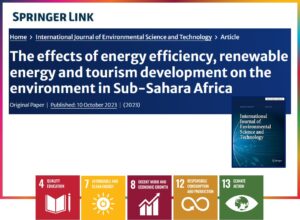
The persistent concern over carbon emissions (CE) has been a global apprehension, prompting the United Nations’ pursuit of Sustainable Development Goals (SDGs), particularly the ambitious objective of achieving carbon neutrality by 2030. Recognized as a significant catalyst for global warming, diseases, and ecological disruptions, CE warrants rigorous examination of factors contributing to its exacerbation and mitigation. Amidst these inquiries, tourism development has drawn attention as a potential CE influencer, yet studies exploring its precise impact remain scarce.
This research aims to delineate the intricate relationship between tourism development, energy efficiency (EE), and CE in Sub-Saharan African (SSA) nations—a study area of considerable originality and significance. Leveraging an extensive panel dataset spanning 48 SSA countries from 1990 to 2020, the study employs robust methodologies like the Cross-Sectionally Augmented Autoregressive Distributive Lag (CS-ARDL) method and the dynamic panel data technique, ensuring the reliability and robustness of outcomes.
The findings unearth pivotal insights: Energy Efficiency (EE) and Renewable Energy (RE) emerge as crucial mitigators, exhibiting a significant negative correlation with CE. Conversely, Non-Renewable Energy (NRE) consumption and Economic Growth (EG) are identified as primary contributors to CE escalation in SSA nations. Notably, contrary to conventional notions, tourism arrivals demonstrate no substantial impact on CE within the SSA region.
This research holds theoretical significance by reinforcing established knowledge that economic growth and NRE are principal drivers of CE escalation. Moreover, it highlights the pivotal role of RE and EE in curtailing CE. Additionally, the study dispels previous claims associating tourism development with CE exacerbation in SSA nations.
Practically, the study advocates for policy directives: Encouraging efficient energy usage, promoting RE consumption for its environmental friendliness, and discouraging NRE utilization due to its detrimental environmental impact. The research emphasizes the importance of recognizing factors driving environmental degradation and those contributing to its mitigation in the SSA region.
The implications of this study resonate with the SDGs’ objective of carbon neutrality by 2030, aligning policy recommendations to foster sustainable energy practices. Moving forward, expanding research across diverse world regions to explore the influence of tourism development on CE remains an avenue for further investigation, vital for shaping sustainable environmental policies globally.
For further details, access the original paper from the publisher’s link:
https://link.springer.com/article/10.1007/s13762-023-05237-5
